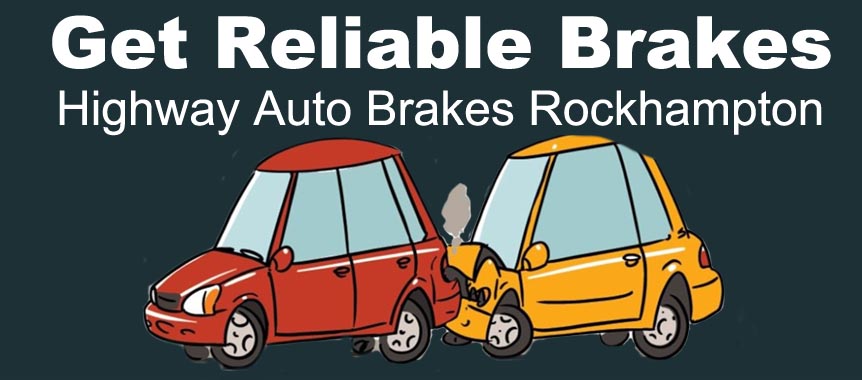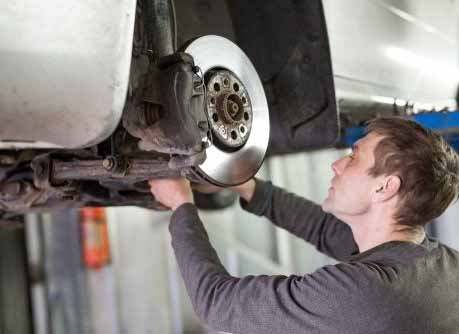Home > Brake Repairs
Business Star Rating:

ALL ABOUT BRAKES-MENU For everything from the brake pedal to the brake disc rotor and back to the brake fluid master cylinder.
Brakes to stop you sooner best by HAE Brakes Rockhampton
Rockhampton’s car brake specialists. Disc machining, Brake fluid flush, Brake pad kits. Quality brake services stop you quickly, so you stay safe.
As your trusted Rockhampton brake service centre, we will quickly diagnose the problem and tell you what needs to be done for safe and efficient brakes and all costs associated with fixing any issues. So book now for our FREE BRAKE inspection (07) 4926 1303.
The benefits of using Highway Auto, The Brake Specialists:
- We strive to give you the shortest braking distance
- Accurate appraisal of brake component condition
- Careful measuring of critical brake components
- Matching the best brake pads to your discs
- Test brake fluid use by date
- Option to replace standard rotors with performance ones
- Check brake warning light system
- Lifetime quality guarantee*
Brake Failure Early Warning Signals
You will know something's wrong with your brakes when you hear a grinding or scraping noise, pulling to one side when you slow down, or even a spongy brake pedal. The first step in diagnosing the source of the problem is understanding the main parts of a brake system and how they work together.
When you depress the pedal for your car brakes, calipers clamp the brake pads onto the rotors to reduce speed and then stop the vehicle. Brake pads get the credit as the main component in stopping, but equally important are the rotors.
These fast-wearing parts of a vehicle’s braking system should be inspected regularly.
All Services Quick Menus
MENU - Auto Air-conditioning MENU - Brakes. MENU - Vehicle Electrical Systems. MENU - Mechanics & Servicing. MENU - New Car Servicing MENU - Radiator & Cooling. MENU - Car & 4WD Servicing ANTI-THEFT Systems HUMM Pay -- Smart Payment Options Zip Pay -- Easy Payment Options Contact Us, Find Us, See Our Map, Get a Quote, Make a Booking
Accurate Diagnosis of Vehicle and Caravan Brakes
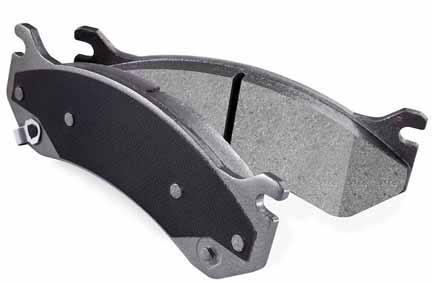 Silent partners helping to reduce noise and vibration are the brake pad shims. Shims are made of metal or rubber and found on the back of brake pads, in between the pads and the calipers. In addition to reducing noise and vibration, shims manufactured from titanium also protect calipers and fluids from damage caused by excessive heat.
Silent partners helping to reduce noise and vibration are the brake pad shims. Shims are made of metal or rubber and found on the back of brake pads, in between the pads and the calipers. In addition to reducing noise and vibration, shims manufactured from titanium also protect calipers and fluids from damage caused by excessive heat.
To work effectively, the brake pads must be able to absorb enough energy and heat. When there is too much wear or heat, brake pad efficiency is reduced, along with your stopping power.
An early warning tell are the car brake pad indicators which are designed to emit a scraping sound when the pads are worn out. If you hear this or a grinding sound when you apply your brakes, the pads need replacing.
Contact Us, Find Us, Get a Quote, Make a Booking
Brake Rotor and Caliper
 When you press the brake pedal, the hydraulic pressure in the calipers cause the brake pads to clamp down on the rotors (also called brake discs). When pressure is applied to the brake rotors, it prevents the wheel from spinning, which means that your brake rotors are as important as the pads when it comes to safety.
When you press the brake pedal, the hydraulic pressure in the calipers cause the brake pads to clamp down on the rotors (also called brake discs). When pressure is applied to the brake rotors, it prevents the wheel from spinning, which means that your brake rotors are as important as the pads when it comes to safety.
Most rotors are made from cast iron—more specifically, grey iron—because it disperses heat well, which is important to avoid overheating and brake fade. High performance vehicles use ceramic rotors, which are lighter and more stable at high speeds and all temperatures. They are, however, more expensive.
You can trust the experienced professionals at Highway Auto Electrics to give you accurate honest, straight answers.
Troubleshooting Brake Rotors
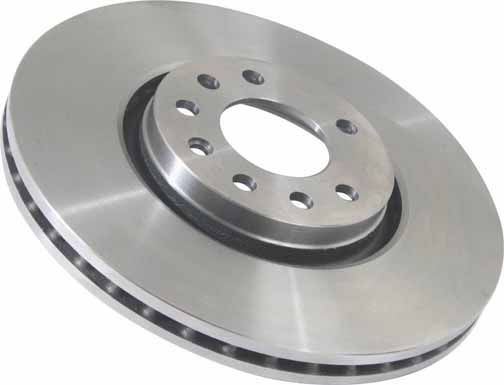
Rotors will need to be replaced by 100,000 km on most vehicles, but it depends on use. Rotors, like brake pads, should be replaced in pairs for even stopping performance. Your rotors may need to be replaced if you see or hear any of these signs:
- Grooves worn into the rotor by the brake pads
- Squealing, squeaking, or grinding sounds when braking
- Vibration or wobbling when braking.
Troubleshooting Brake Fluids
 Brake fluid needs to be changed out after 24 months or sooner in adverse conditions so have it tested every 12 months to be on the safe side. We test brake fluid for free in the interest of road safety.
Brake fluid needs to be changed out after 24 months or sooner in adverse conditions so have it tested every 12 months to be on the safe side. We test brake fluid for free in the interest of road safety.
Brake fluid is "incompressible," so that when the brake pedal is pushed, the fluid forces brake parts to work together to slow the wheel. Brake fluid also lubricates parts in the braking system. There are four designations of brake fluid: DOT 3, DOT 4, DOT 5, and DOT 5.1.Each contains a mixture of chemicals with specified dry and wet boiling points. When your brake fluid has just been replaced, this is called the “dry” boiling point temperature.
As water finds its way into the hydraulic system, the “wet” boiling temperature is the benchmark you should use. To choose the best brake fluid for your vehicle, consult your owner's manual or come and see us at Highway Auto.
Because brake fluid is also hygroscopic (attracts water) it starts degrading the moment the bottle is opened, so it should be replaced every two years. A sure sign that your brake fluid is degrading is a 'spongy' brake pedal, or a pedal that continually creeps toward the floor. When this happens, it's time to look at replacing your brake fluid, or bleeding air from the brake fluid lines. Best not to let it degrade to that state as emergency braking is compromised.
Contact Us, Find Us, Get a Quote, Make a Booking
Car Brake Shoes
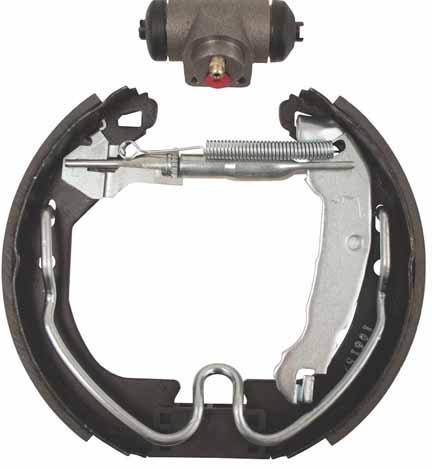 Brake shoes are the curved, metal friction plates pressing against the inside of the brake drums to slow the wheels. While disc brake systems are more effective, drum brakes are cheap to manufacture (and therefore cheaper to replace). Many vehicles feature a drum brake system on the rear axles and let the disc brakes take on the real heat in the front.
Brake shoes are the curved, metal friction plates pressing against the inside of the brake drums to slow the wheels. While disc brake systems are more effective, drum brakes are cheap to manufacture (and therefore cheaper to replace). Many vehicles feature a drum brake system on the rear axles and let the disc brakes take on the real heat in the front.
Brake Calipers
 Calipers are usually long lasting but problems can arise. Here are a few things to look out for:
If the caliper is leaking, replace it.
If the piston dust boot is torn, chances are you’ve already damaged the piston seal, so you'll need to replace that, too.
If the caliper isn’t leaking and the boots are intact, the caliper is probably good to go for your next brake pad replacement.
Calipers are usually long lasting but problems can arise. Here are a few things to look out for:
If the caliper is leaking, replace it.
If the piston dust boot is torn, chances are you’ve already damaged the piston seal, so you'll need to replace that, too.
If the caliper isn’t leaking and the boots are intact, the caliper is probably good to go for your next brake pad replacement.
Sometimes the square cut “O” ring inside the caliper can harden and prevent the piston from retracting. This can cause uneven brake pad wear (the outboard pad wears faster than the inboard because the caliper can’t release pressure). But, corroded pad slides and caliper pins can also cause uneven brake pad wear, and they’re much cheaper and easier to replace than a caliper, so we would try replacing those parts first.
Anti-Lock Brakes
 These days, ABS, or ALB (the two common acronyms for anti-lock brakes) is offered as standard equipment on all new cars and many light and heavy commercials.
These days, ABS, or ALB (the two common acronyms for anti-lock brakes) is offered as standard equipment on all new cars and many light and heavy commercials.How it works:
When braking under adverse conditions, such as slippery roads, the level of grip between the tyre and road surface may be exceeded, allowing wheels to lock and skid. When this occurs, braking efficiency is very much reduced, the car may spin out of control and the driver is likely to lose the ability to steer accurately.The wheel speed sensors constantly send information to the computer, enabling it to detect impending lock-up of any or all wheels during braking. When lock-up is imminent, the computer instructs the hydraulic modulator to apply and release the brakes on the wheel/wheels that are locking up, up to 15 times per second.
The wheel speed sensors constantly send information to the computer, enabling it to detect impending lock-up of any or all wheels during braking. When lock-up is imminent, the computer instructs the hydraulic modulator to apply and release the brakes on the wheel/wheels that are locking up, up to 15 times per second.
In this way the car’s braking and directional stability is maintained and the driver retains the ability to steer the car to avoid a potential collision.
At all other times the brakes work like a normal braking system, only entering ABS mode when necessary, with vehicle speeds above about 6kph.
Brake pedal kick back
During ABS brake operation the brake pedal may pulse or “kick back” under the foot, and thumping noises from the pedal area, and vibration in the vehicle body and steering may be evident. These are all normal characteristics, though many drivers may find these sensations a little alarming at first.
Under ABS braking conditions it is very important to maintain pressure on the brake pedal, to allow the system to take control. The driver must concentrate on steering to avoid hazards.
Brake Assist and other enhancements
ABS systems often incorporate other functions. These include:
Brake Assist, which detects a rapid or emergency brake application and applies maximum brake force, regardless of the actual pedal pressure applied by the driver.
Hill Hold prevents the vehicle rolling backwards during hill starts.
Traction Control prevents the drive wheels from spinning on low traction surfaces.
Dynamic Stability Control reduces the risk of loss of control during manoeuvres.
Hill Descent Control is used to maintain traction and control vehicle speed during off road hill descents.
Stopping distances
In general, ABS equipped cars will have similar braking distance to non-ABS cars.
However, this distance will vary according to several factors, including the type of road surface.
On some roads, especially those covered in snow or loose gravel, stopping distances may be longer than with a non-ABS car. In these conditions, the wedge of loose material pushed up in front of the locked wheels also helps slow the car.
The primary function of ABS is to ensure the car’s directional stability under adverse braking conditions.
ABS can’t prevent an accident caused by following too closely.
When it stops working
The system incorporates a dash warning light to advise the driver of a system fault.
If the lamp illuminates while driving, the ABS system will be disabled, the system will return to standard non-ABS brake operation and other related functions may cease to operate.
If the lamp illuminates while driving, the ABS system will be disabled, the system will return to standard non-ABS brake operation and other related functions may cease to operate.
With the standard brakes operating, the car can still be driven, though it should be taken promptly to a repairer for attention to the ABS system (Consult the owner’s handbook for further detail).
Examples of vehicles we service
● Audi
● BMW
● Daewoo
● Daihatsu
● Datsun
● Fiat
● BMW
● Daewoo
● Daihatsu
● Datsun
● Fiat
● Ford
● Holden
● Honda
● Hyundai
● Isuzu Ute
● Jeep
● Holden
● Honda
● Hyundai
● Isuzu Ute
● Jeep
● Kia
● Land Rover
● Lexus
● Mazda
● Mini
● Mitsubishi
● Land Rover
● Lexus
● Mazda
● Mini
● Mitsubishi
● Nissan
● Subaru
● Suzuki
● Toyota
● Volkswagen
● Volvo
● Subaru
● Suzuki
● Toyota
● Volkswagen
● Volvo
Make your Car, SUV, 4WD brake repair booking now.
 For any of the above services or for any automotive repairs, Mechanical, Air-conditioning, Auto electrical, Cruise control, Caravan services, Bosch, Delkor and Century Batteries.
For any of the above services or for any automotive repairs, Mechanical, Air-conditioning, Auto electrical, Cruise control, Caravan services, Bosch, Delkor and Century Batteries.
You can speak with Cathy or Steve who will talk you through any automotive service questions and advice; they are well-informed, patient, professionals. (07) 4926 1303 Contact Us, Find Us, Get a Quote, Make a Booking
